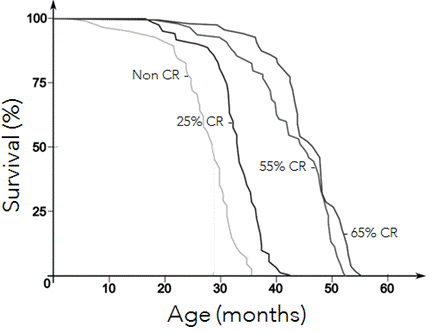
Anti-Aging Science
Caloric Restriction Mechanism
It is well known that limiting food consumption, fasting cures and certain diets may contribute to a healthy and longer life.
Calorie restriction is a specific dietary regimen that involves reducing calorie intake by between 25% and 65%, while maintaining optimal levels of protein, vitamins and minerals. Calorie restriction has been demonstrated in a variety of species, including yeast, apes, mice and rats, to protect against stress and decelerate the biological aging process, resulting in improved health span and extended lifespan.

Caloric restriction (CR) increases lifespan in mice.
Data taken from: Weindruch R, et al. (1986). Journal of Nutrition, April, 116(4), 641-54.
In individuals who are undertaking calorie restriction, it was found that a fundamental biochemical pathway is blocked. It is named insulin/IGF-1 pathway with the insulin/IGF receptor as central activation button.
This pathway is switched on when blood glucose levels are high, for example following a satisfying meal. As a result, the hormone insulin is produced, which perfectly fits into the insulin/IGF-1 receptor and therefore starts the cascade. This leads to an inactivation of FOXO downstream. This master switch is responsible for the activation of important detoxification and DNA-repair processes and thus promotes longevity. These longevity mechanisms are switched off when FOXO is not active.
In contrast, when glucose blood levels are low due to calorie restriction, this pathway is blocked; FOXO is active and can start longevity mechanisms.
The activation of FOXO can also be achieved during physical training (excercise) through the increase of AMPK.